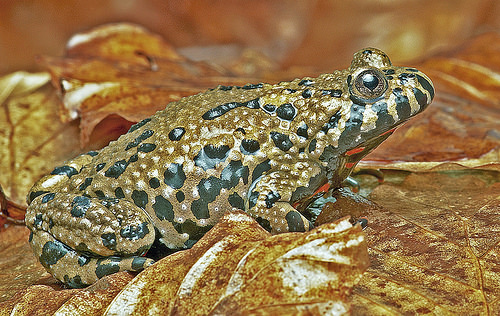Be careful about touching a fire-bellied toad… it can ‘burn’ you.
- Fire-bellied toads, also known as ‘firebelly toads’, are amphibians, and a toad of smaller size, native to central to northern Asia and across Europe.
- Fire-bellied toads typically grow to be 4 to 7 centimetres (1.6 to 2.8 inches) in length and weigh 20 to 80 grams (0.7 to 2.8 ounces).
- The scientific name of a fire-bellied toad is Bombina, that is one of two groups in the family Bombinatoridae, and there are eight species in the genus.
- Depending on the species, the skin of fire-bellied toads contains numerous bumps, and ranges from green, black and brown in colour, while the underside is yellow, red, orange or black, and the bright colour acts as a natural warning that it contains toxins which can be harmful to animals, and can cause a rash in some humans.
- The diet of fire-bellied toads consists primarily of flies, worms, shrimp, beetles, larvae, spiders and other insects.
A Fire-bellied Toad
Image courtesy of Flickpicpete/Flickr
- Unlike most frogs, fire-bellied toads do not produce a croaking sound, but instead a bark, which is used by males to find a mate.
- Female fire-bellied toads lay around 50 to 300 eggs at a time, laid onto vegetation that is situated above a small body of water, and they develop into tadpoles, and eventually toads, that have an average lifespan of ten to fifteen years.
- Triangular or heart shaped pupils can be found in the eyes of some fire-bellied toads, and they can arch their backs and flip upside down to show their bright coloured bellies to scare away predators like birds, lizards, foxes and snakes.
- Some fire-bellied toad species are listed as vulnerable or endangered due to habitat loss, and disease is also a possible cause of the decline in numbers in some species.
- Fire-bellied toads generally live alone near fresh water ponds and streams, in forest and swamp habitats, and some species are kept as pets.
Bibliography:
Fire-bellied Toad, 2013, A-Z Animals, http://a-z-animals.com/animals/fire-bellied-toad/
Fire-bellied Toad, 2015, Wikipedia, http://en.wikipedia.org/wiki/Fire-bellied_toad
Oriental Fire-bellied Toad, 2015, National Geographic, http://animals.nationalgeographic.com.au/animals/amphibians/oriental-fire-bellied-toad/








